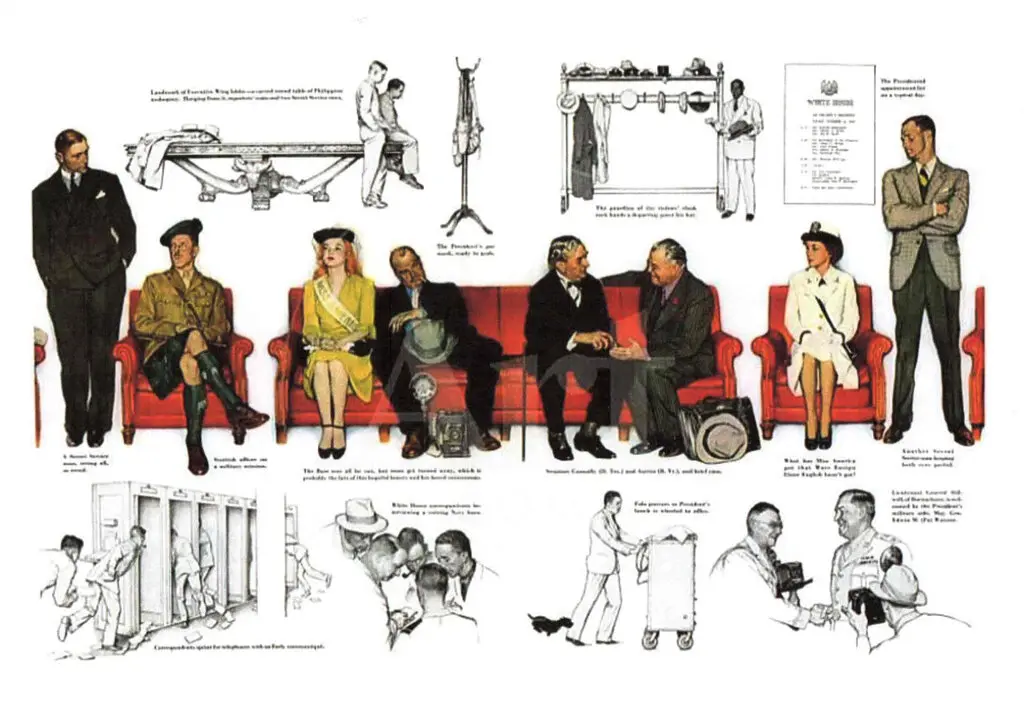Law & Politics
A Judge Has Ruled in the Bitter Ownership Dispute Over Norman Rockwell Works That Once Hung in the White House
Was a long term loan to the White House used to disguise the theft of four valuable Rockwell drawings?

Was a long term loan to the White House used to disguise the theft of four valuable Rockwell drawings?

Jo Lawson-Tancred

A bitter family dispute over how to split the inheritance of four Norman Rockwell drawings that hung in the White House for decades may finally be resolved. A federal judge upheld the ownership claim of just one of the possible heirs, William Nile Elam III.
The complicated quarrel centered around a series of illustrations known as “You Want to See the President,” which were completed by Rockwell during a visit to the White House in 1943 and published in The Saturday Evening Post. They show several classic American figures, including a senator and a beauty pageant queen, lining up to meet Franklin D. Roosevelt. They hung in the White House between 1978 and 2022.
At the time of their completion, the original artworks were given to the president’s press secretary Stephen T. Early, whose heirs are now squabbling over their ownership. The contest began in 2017, when Early’s son Thomas Early saw the drawings hanging in the West Wing of the White House in the background of an interview with Donald Trump. He decided his nephew William Nile Elam II must have lent them without the family’s permission and requested that the works be taken down, which they eventually were last year. (The White House has not been accused of any wrongdoing.)
According to Elam’s account, Stephen Early gave the illustrations to his daughter, Helen Early Elam on the occasion of her graduation in 1949, just a few years before he died. She in turn gave them to her son William Elam, who lent them to the White House in 1978. In February of this year, Elam sought to set this version of events in stone by asking Virginia District Court to award him ownership.

An illustration from Norman Rockwell’s 1943 series, You Want to See the President. Courtesy of the U.S. District Court for Eastern Virginia.
Though Thomas Early died in 2020, another of his sisters and his sons filed a counterclaim against Elam III, arguing that Helen Early Elam could not have legally passed on sole ownership of the illustrations to her son since she only owned one-third of the series. They said that she asked Thomas Early to borrow the works for an exhibition in San Francisco in 1980, suggesting that she couldn’t have believed she was their sole owner.
“William Elam took the Rockwells to the White House to conceal his removal of the artwork from his grandmother’s house,” the filing also alleged, “and to hide the Rockwells for a significant time period to ‘launder’ or ‘wash’ the ownership of artwork, in the effort to obtain sole ownership.” The relatives of Thomas Early also claimed that the fact the works were loaned anonymously was part of Elam’s scheme. They sought ownership and $350,000 in punitive damages.
It is not clear how they arrived at this figure but, in 2017, an unnamed auction house made an initial “unofficial appraisal” that the works could be worth around $8 million.
Elam’s claim was upheld by Judge Michael S. Nachmanoff of Federal District Court in Alexandria, Virginia, on October 31. He found that the case had a “clear outcome,” in part because when Stephen Early died in 1951, the illustrations were not listed in the official accounting of his estate, a document that was signed under oath by his wife Helen Early. “One can then conclude that the Illustrations were not part of Grandfather Early’s estate because he had already gifted them during his lifetime,” the judge decided.
There was also evidence, backed by a letter to the Rockwell Museum written in 1990 by Helen Elam, that the Rockwell illustrations had been in the possession of Elam or his mother since at least 1960, a full 18 years before they were lent to the White House. Though the defendants contested this, they were not able to explain where the Rockwells would have been instead between 1960 and 1969 and the only Early family estate to reference the works was Helen Elam’s.
The judge ruled that, based on the available evidence, Elam was “entitled to benefit from the common law presumption of ownership.”
The relatives’ only hope of countering this entitlement would have been to prove that Elam’s possession of the works was the result of theft. However, the judge said they were not able to put forward “the kind or quantity of evidence to establish theft.” They were unable to prove their assertion that Elam had lent the works to the White House anonymously to intentionally hide his identity, or that the loan was part of a grander scheme to assume sole ownership. According to Elam’s lawyers, the works were lent to the White House after thieves attempted to break into the home of Helen Early, Stephen Early’s wife and Elam’s grandmother, who died in 1978.
The illustrations have returned to Elam’s possession and, according to the New York Times, his lawyers said “he feels vindicated.”
More Trending Stories:
This 15th-Century Painting Might Actually Depict a Prehistoric Tool, New Research Suggests